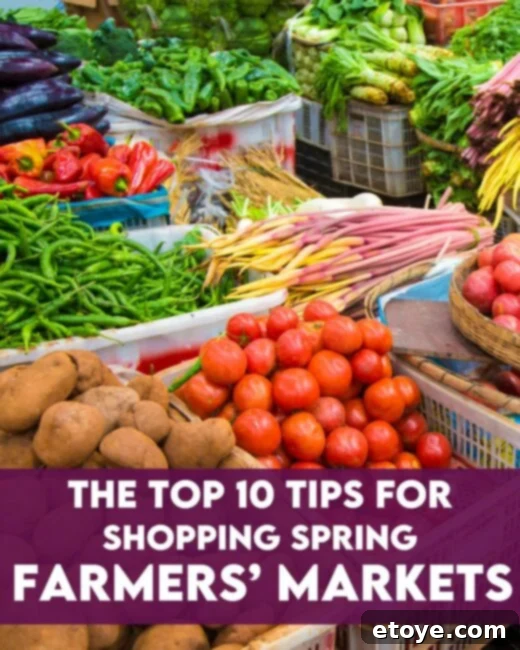Spring has officially sprung, bringing with it a vibrant array of colors, scents, and a renewed sense of community. While your trusty grocery store serves its purpose for convenience (who hasn’t made a late-night ice cream run?), there’s an unparalleled charm and quality waiting for you at your local farmers’ market. Imagine stepping into an open-air wonderland, brimming with the freshest produce, artisan goods, and the friendly faces of the people who grew or created them. This season, transform your food shopping into an experience – a journey that connects you directly to the source of your sustenance and the heart of your local community.
This comprehensive guide will equip you with all the essential tips and insights to navigate your farmers’ market like a seasoned pro. We’ll explore the myriad reasons why these markets are a must-visit, highlight the delectable spring treasures you can expect to find, and share actionable strategies to maximize your visit, ensuring you leave with a basket full of wholesome goodness and a deeper appreciation for local agriculture. Get ready to embrace the unique energy, discover new flavors, and support your local economy, all while enjoying the freshest ingredients spring has to offer.
Why Farmers’ Markets Are a Spring Must-Visit

There are countless compelling reasons to bypass the supermarket aisles and head straight to your local farmers’ market this spring. It’s more than just a place to buy food; it’s an experience that nourishes your body, your community, and even your soul.
Unrivaled Freshness and Exceptional Quality: When you shop at a farmers’ market, you’re getting produce that was often picked just hours, or at most a day or two, before it arrives at your hands. This direct farm-to-table journey means your fruits and vegetables retain peak flavor, nutritional value, and a vibrant texture that simply can’t be matched by items that have traveled hundreds or thousands of miles. Spring marks the season when farmers’ markets truly come alive, offering everything from tender leafy greens to the first sweet strawberries, providing unparalleled access to the freshest ingredients possible. Experience the difference in every bite – from a crisp snap pea to a juicy heirloom tomato bursting with sun-ripened flavor.
Boosting Local Economies and Fostering Community Spirit: Every purchase you make at a farmers’ market is an investment in your local economy. Your money directly supports small farmers, local artisans, and small businesses, helping them thrive and sustain their livelihoods. This direct support helps preserve farmland, creates local jobs, and keeps money circulating within your community, contributing to its overall resilience and prosperity. Beyond the economic impact, farmers’ markets are vibrant community hubs where neighbors connect, share recipes, and celebrate the bounty of the season. It’s a place where relationships are built, and a palpable sense of community spirit flourishes.
Forge Connections and Gain Invaluable Knowledge: One of the most unique aspects of farmers’ markets is the opportunity to interact directly with the people who grow your food. Farmers and vendors are passionate experts, eager to share their knowledge. This direct interaction allows you to ask questions about growing practices, understand the seasonality of produce, and even get personalized tips on how to best prepare and store your purchases. Learning directly from the source about the journey of your food from farm to table creates a deeper appreciation for what you eat and empowers you to make more informed culinary choices. These relationships can also lead to discovering new varieties and even better deals on high-quality produce.
Culinary Exploration and Discovery: Ever been curious about an unusual vegetable or an heirloom fruit you’ve never seen before? The farmers’ market is the perfect playground for culinary adventurers. With a diverse array of unique and seasonal offerings, it’s an ideal place to experiment with new ingredients and expand your palate. You’ll find varieties not typically available in conventional grocery stores, offering exciting opportunities to try new recipes and broaden your cooking horizons. Plus, with vendors as your guides, you can confidently select and prepare these new discoveries, knowing they are at their freshest and you have expert advice at hand.
Environmental Benefits and Sustainable Practices: Choosing to shop at a farmers’ market also has positive environmental implications. Reduced transportation distances mean a smaller carbon footprint compared to produce shipped across the country or globally. Many local farmers also employ sustainable and organic farming practices, minimizing the use of pesticides and promoting biodiversity, which is healthier for both the environment and your body. By bringing your own reusable bags, you further reduce waste and contribute to a more sustainable food system.
A Bounty of Spring Delights: What to Expect at the Market

Springtime at the farmers’ market is a feast for the senses, bringing forth a vibrant spectrum of seasonal produce after the long winter. Here’s a detailed look at some of the common in-season spring produce you might discover, along with tips for enjoying them:
1. Asparagus: A true harbinger of spring, asparagus spears are a versatile and delicious vegetable. Look for firm, bright green stalks with tightly closed tips. Beyond simply wrapping them in prosciutto and air frying – a fantastic method for caramelizing their natural sugars – asparagus shines when grilled until tender-crisp, lightly steamed to preserve its delicate flavor, or stir-fried with garlic and a touch of lemon. It makes an excellent side dish or a vibrant addition to pastas and salads.
2. Radishes: These peppery roots add a delightful crunch and a spicy kick to salads, tacos, or as a vibrant garnish. Don’t discard the leafy greens! Radish greens are surprisingly delicious and nutrient-rich; sauté them with olive oil and garlic, or chop them into soups and stews for a unique flavor. Select radishes that are firm, brightly colored, and free of soft spots.
3. Spring Onions (Scallions/Green Onions): Known by various names, spring onions are young onions harvested before the bulb fully forms. Their mild, sweet flavor is less pungent than mature onions, making them perfect for fresh applications. Slice them thinly for salads, salsas, stir-fries, or as a fresh topping for grilled fish, steak, or baked potatoes. Choose those with bright green tops and crisp white bases.
4. Peas (Snap, Snow, and Garden): Spring is prime pea season, and whether you prefer the crisp sweetness of snap peas, the delicate crunch of snow peas, or the tender pop of shelling garden peas, the market will likely have them all. Peas are at their absolute sweetest when freshly picked. Toss snap peas into pasta dishes, stir-fries, or enjoy them raw as a snack. Shelling peas are wonderful in risottos, stews, or simply blanched and buttered.
5. Spinach: This incredibly nutritious leafy green is a spring staple. Its versatility allows it to be incorporated into countless dishes. Spinach wilts beautifully in warm dishes like omelets, quiches, or sautéed with garlic, while it remains crisp and refreshing in cool salads and smoothies. Look for vibrant, dark green leaves without yellowing or wilting.
6. Lettuce and Salad Greens: Spring ushers in an abundance of flavorful salad greens far beyond basic iceberg. From the tender leaves of butterhead and red leaf lettuce to the peppery bite of arugula and the slight bitterness of radicchio, the farmers’ market is a cornucopia of fresh options. Create vibrant, textural salads with these fresh-from-the-farm greens, often offering a flavor profile far superior to their supermarket counterparts.
7. Strawberries: The undisputed superstar of springtime fruits, farmers’ market strawberries are a revelation. Often smaller and more intensely flavored than store-bought varieties, they boast unparalleled juiciness and sweetness. Enjoy them fresh out of hand, sliced into spring salads, atop yogurt, or transform them into decadent desserts like shortcakes or pies. A simple drizzle of balsamic glaze or a dip in honey or Nutella elevates their natural flavor.
8. Rhubarb: While not typically eaten raw due to its tartness, rhubarb is a baking essential for spring. Its vibrant stalks, ranging from deep red to pale green, are perfect for pies, crumbles, jams, and compotes. Its sour notes beautifully balance the sweetness of other fruits like strawberries or apples, creating classic flavor combinations that evoke the essence of spring.
9. Artichokes: These impressive thistles are a true spring delicacy. While they require a little effort to prepare, the tender hearts and fleshy bases of the leaves are incredibly rewarding. Steam or grill whole artichokes and serve with a dipping sauce, or extract the tender hearts to use in creamy dips, pasta dishes, or on pizzas. Choose globe artichokes that are firm, heavy, and have tightly closed leaves.
10. Baby Potatoes: Unlike their mature counterparts, baby potatoes are harvested young, making them smaller, less starchy, and with incredibly tender skins that don’t require peeling. Their delicate texture and subtly sweet flavor make them ideal for roasting with herbs, boiling for potato salads, or adding whole to stews and pot roasts. Look for firm, unblemished potatoes.
11. Fresh Herbs: Nothing says springtime like the fragrant aroma of fresh herbs. Your farmers’ market will likely offer both cut bunches and potted plants, making it an ideal time to start an herb garden. Look for popular choices like aromatic basil, cooling mint, vibrant cilantro, earthy rosemary, and versatile parsley. Fresh herbs elevate any dish, adding bright, nuanced flavors that dry herbs simply can’t replicate.
Your Ultimate Guide to a Successful Farmers’ Market Trip

To truly master the farmers’ market experience and reap its full benefits, a little preparation and strategic thinking go a long way. Here are essential tips to make your visit productive, enjoyable, and budget-friendly:
1. Planning Your Visit: The Strategic Shopper’s Blueprint: Every successful market trip begins with a plan. Before you go, consider researching the market’s website or social media for operating hours, a list of vendors, and what’s expected to be in season. Create a rough shopping list based on your meal plans for the upcoming week. This blueprint will help you stay focused amidst the tempting array of produce and artisan goods, preventing impulse buys and keeping you within your budget. Knowing what you generally need will guide your exploration without limiting discovery.
2. Smart Shopping: Avoid Overbuying & Embrace Seasonality: The “golden rule” of farmers’ markets is to purchase with purpose. It’s incredibly easy to get swept up in the excitement and buy more fresh, perishable items than you can realistically consume before they spoil. Think about your upcoming meals and how much produce you can use within a few days to a week. Buying strategically not only saves you money by preventing food waste but also deepens your understanding of seasonal eating, encouraging you to incorporate what’s truly fresh and abundant into your diet.
3. Cash is King: Streamlining Transactions & Supporting Local: While many markets and vendors now accept debit and credit cards, cash remains the preferred payment method for many small farmers and local producers. This is often because it allows them to avoid credit card processing fees, which can significantly eat into their profits. Sometimes, these savings are even passed on to you through better prices! It’s wise to bring smaller denominations and change for smoother transactions. Having cash also serves as a built-in budgeting tool, helping you stick to your pre-determined spending limit.
4. Eco-Friendly Habits: The Power of Reusable Bags: Farmers’ markets are inherently aligned with sustainability, and you can contribute to this ethos by bringing your own reusable bags. This simple act reduces the demand for single-use plastic bags, minimizing waste and helping the environment. Vendors also appreciate you saving them materials and resources. Consider bringing separate bags for different types of produce, and even reusable containers for items like berries, eggs, or bulk grains if offered, further enhancing your eco-conscious shopping experience.

5. Engage with Vendors: Your Personal Food Experts: Remember, market vendors are more than just sellers; they are a treasure trove of information. Don’t hesitate to ask questions! Wondering about a unique variety of squash? Unsure how to best store those vibrant greens? Need a recipe idea for an unfamiliar herb? Ask! This interaction is a unique opportunity to learn directly from the source – something rarely possible at conventional grocery stores. Most farmers are eager to share tips on selection, storage, and preparation, fostering a valuable connection between you and your food source.
6. Know What’s in Season: The Key to Quality and Authenticity: Arming yourself with knowledge about what produce is in season locally is crucial. This not only helps you anticipate what will be available and at its freshest but also acts as an indicator of a vendor’s authenticity. If a vendor is selling produce that is clearly out of season for your local area (e.g., pumpkins in spring), it’s a sign they likely sourced it from outside the region, potentially from a wholesaler rather than their own farm. Be wary of produce still bearing supermarket tags or packed in large, branded boxes. Knowing what’s genuinely local ensures you’re truly supporting regional agriculture and enjoying the highest quality seasonal offerings.
7. The Art of Inspection: Smart Produce Selection: While most vendors pride themselves on quality, it’s always wise to give your potential purchases a quick check. For items like berries or tomatoes sold in boxes, gently lift the top layer to ensure there are no bruised, moldy, or rotten items hidden underneath. However, don’t shy away from “ugly” produce! Some of the most flavorful fruits and vegetables might not be conventionally picture-perfect, and vendors often offer great deals on these perfectly good but aesthetically unconventional items. Prioritize freshness, firmness, and fragrance over flawless appearance.
8. Leveraging SNAP & Food Assistance Benefits: Farmers’ markets are increasingly becoming vital resources for low-income communities. Many markets across the United States are SNAP (Supplemental Nutrition Assistance Program)-friendly and offer incredible incentive programs, often doubling the value of food stamps. This means every dollar of SNAP spent at a participating market could be worth two, making fresh, healthy produce significantly more accessible and affordable. Inquire at the market’s information booth about their specific programs and how to utilize your benefits, contributing to food security and healthy eating for all.
9. The Full Market Stroll: Comparing & Discovering: Upon arrival, resist the urge to buy from the very first stand that catches your eye, especially if it’s not a limited-quantity item. Instead, take a leisurely stroll through the entire market first. This strategic approach allows you to survey all the offerings, compare prices for similar products, and discover unique items you might have missed. Different vendors selling the same produce, like leafy greens or artisan bread, may have varying prices or slightly different qualities. A full lap before you start buying ensures you find the best deals and make the most informed choices for your basket.
10. Food Safety First: Washing Your Market Haul: This final tip is paramount: always thoroughly wash your produce once you bring it home from the market. Since farmers’ market produce often comes directly from the field, it can carry dirt, bacteria, potential pesticide residues, or even small insects. Washing your fruits and vegetables under cool running water helps remove these contaminants and significantly reduces the risk of foodborne illness, promoting optimal food safety. For delicate berries, a quick soak (no more than 4 minutes) in a solution of one part white vinegar to four parts water, followed by a rinse and thorough drying, can help remove spores and extend their shelf life in the refrigerator.
Embrace the Farmers’ Market Experience!

With these tips and insights, you are now well-equipped to fully embrace your farmers’ market journey, whether you’re a first-time visitor or a seasoned shopper looking to refine your approach. There’s a truly unique magic in walking through a local market, discovering an abundance of fresh, seasonal foods, connecting with dedicated farmers and artisans, and bringing home a basket brimming with hand-selected treasures. It’s an experience that nourishes not just your pantry, but your connection to the food you eat and the community you live in.
Here’s an extra pro tip: Before your next trip, check out the market’s social media accounts or website. They are often fantastic resources for updates on new vendors, special events, cooking demonstrations, or even what produce is expected to be abundant that week. This can help you tailor your game plan and ensure you don’t miss out on anything exciting!
Do you frequent farmers’ markets? What are your favorite finds or secret strategies? Have you ever picked up something entirely new and fallen in love with it? We’d love to hear all about your farmers’ market adventures and discoveries in the comments below!
Happy eating, and we’ll see you at the market!
